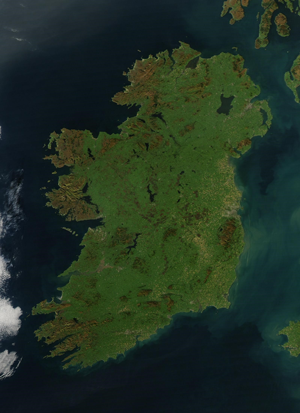In Praise of Irish Astronomy
[This week's guest blogger is our own solar scientist, Dr. Claire Raftery, regaling us with Ireland's rich astronomical history in honor of St. Patrick's Day.]

Once the largest telescope in the world, the Leviathan of Parsontown. [Photo credit: TCD]
Ireland, the Emerald Isle, is a land rich in lore, myths and leprechauns. Superstitions and old wives tales are as revered as the rule of law. Its lush greenery is as a result of the wet climate, and world travelers know that a visit to Ireland requires rain boots and an umbrella. Overcast skies and rain showers help to keep the Green Island so green. However, did you know that Ireland also has been a center of astronomy for many centuries—despite the rain! In fact, Ireland was home to the largest telescope in the world for more than 70 years. The Leviathan of Parsonstown (formally called the Rosse six-foot telescope) is located at Birr Castle on the estate of the Earl of Rosse in Birr, County Offaly. This spot is now the heart of Irish radio astronomy, and is home to the Rosse Solar-Terrestrial Observatory, operated by Trinity College Dublin.
Ireland’s astronomical roots begin more than 5,000 years ago with the building of the Newgrange Passage Tomb around 3,200BC, making it older than Stonehenge and the Great Pyramids of Giza. This ancient temple demonstrates the astronomical knowledge the ancient Irish people held by virtue of a small opening above the main door which is in exact alignment with the Sun on the day of the Winter Solstice . The inner chamber is illuminated only between December 19th to 23rd every year. It is believed that this was used as a time telling device to mark the new year, and to show the victory of life over death.
Ireland's connections to the skies have continued to grow and evolve. Besides Rosse Observatory, there are a number of observatories across the country, not least of which is Dunsink Observatory. Now run by the Dublin Institute for Advanced Studies , Dunsink was once the home of Irish timekeeping. Dublin Mean Time (DST) was defined by the Observatory, located just outside of the city center and would have been 25 minutes and 21 seconds behind Greenwich Mean Time . Its most famous Director was William Rowan Hamilton, famous for his discovery of quaternions. The idea occurred to him when out walking with his wife. Short of a pen and paper, he inscribed the equation into the side of nearby Broom Bridge, and the inscription can be seen to this day.
To this day, the observatory at Dunsink continues to use a telescope built by the Grubb family from Dublin. Grubb have supplied telescopes, lenses and clock drives for equatorial mounted telescopes to many famous observatories all over the world, including the Royal Observatory in Greenwich, the Vienna Observatory and the Great Melbourne Telescope.

Ireland Satellite: The Emerald Isle from above. [NASA image courtesy Jeff Schmaltz, MODIS Rapid Response Team, Goddard Space Flight Center.]
For a country whose luscious grass means few days when the sky is clear, Ireland has more than made its mark on the study of the skies.
On this day of Irish celebration, let us with you all
Lá Fhéile Pádraig sona dhaoibh!
1302